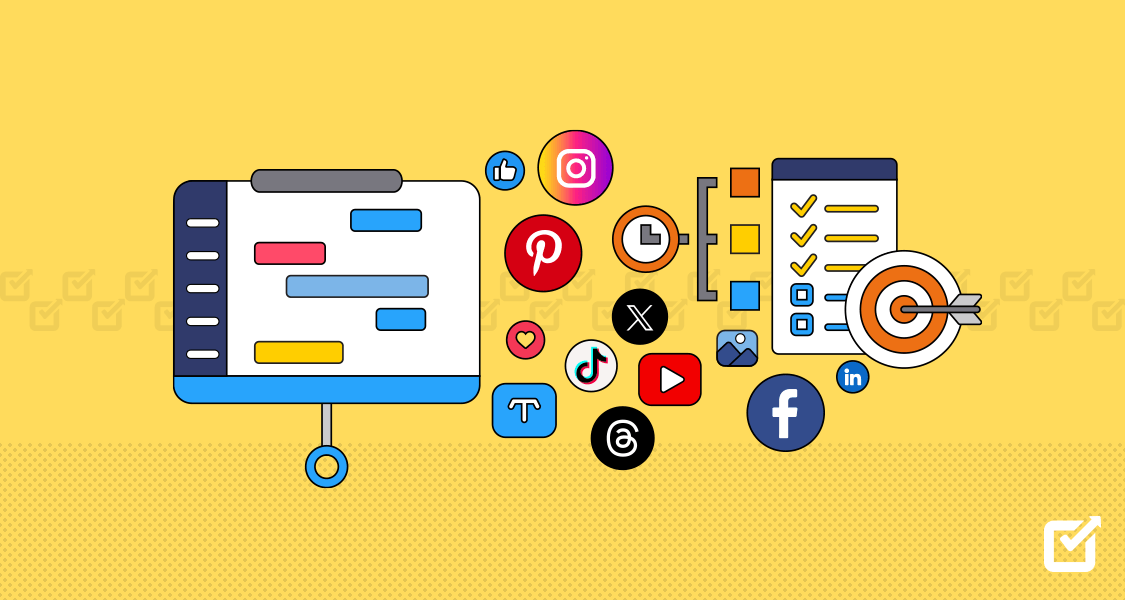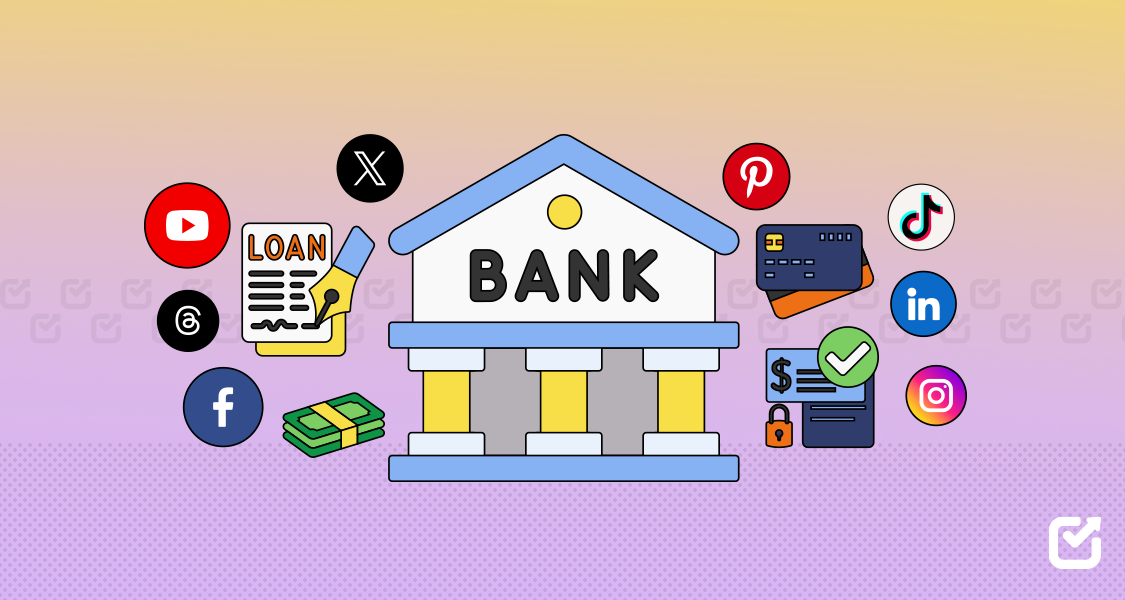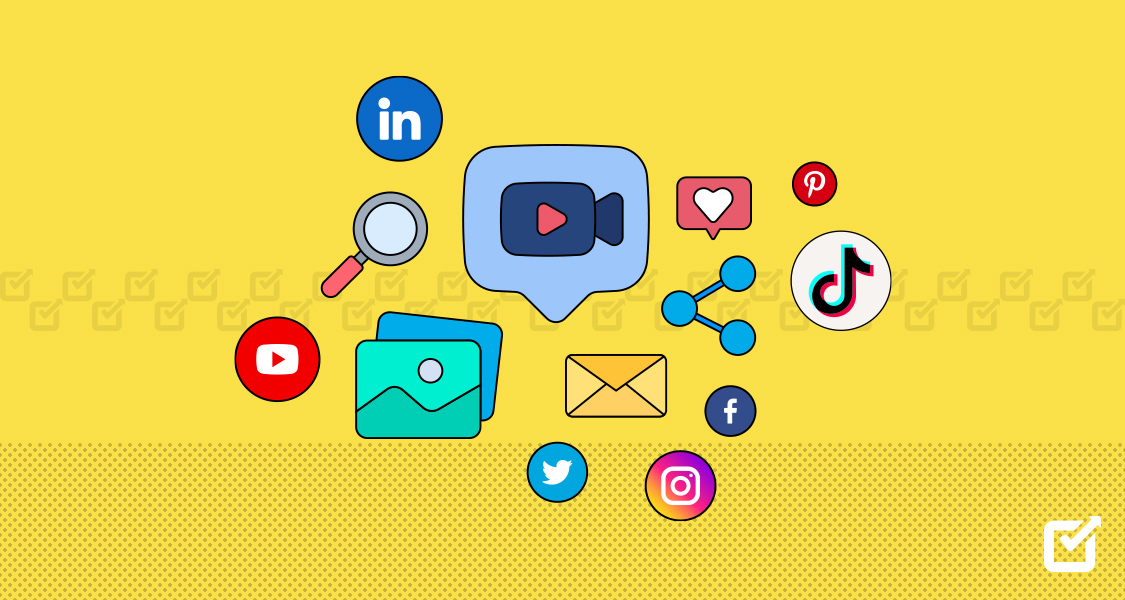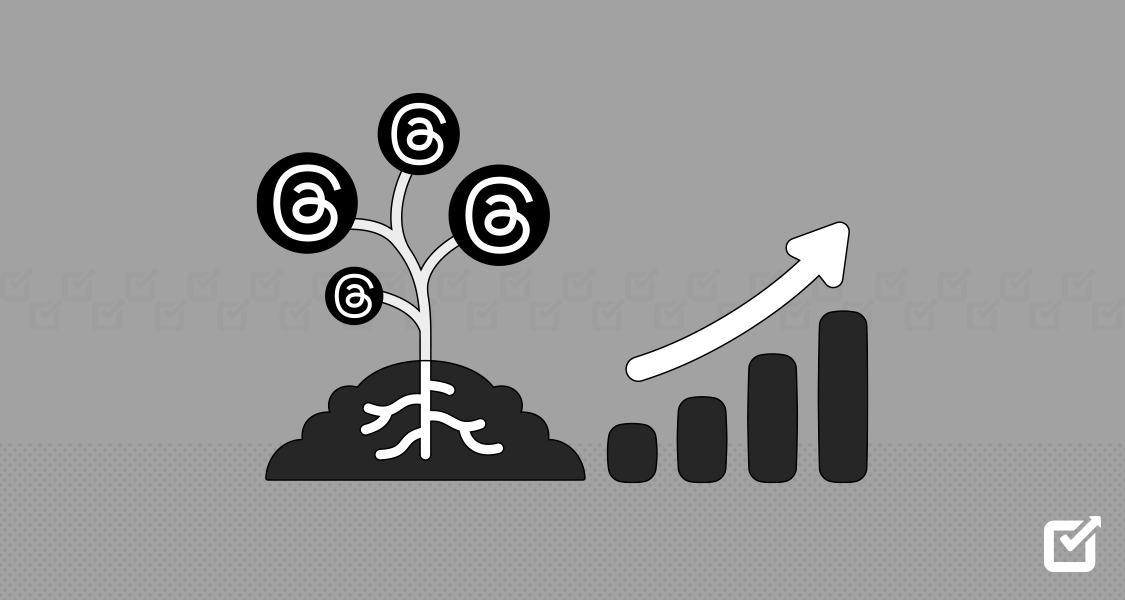Running social media for multiple clients isn’t easy
Between scheduling posts, replying to messages, tracking performance, and keeping up with every platform’s updates, things can get overwhelming fast.
And if you’re using different tools for each task, it only adds to the chaos.
That’s why choosing the right Social Media Management Tools is so important for agencies.
The right platform can simplify your workflow, save you hours each week, and help your team stay in sync across all client accounts.
But not every tool is built with agencies in mind. Some are too limited. Others lack features like collaboration, client approvals, or custom reporting.
To make your job easier, we’ve put together a list of the 12 best tools designed to help agencies succeed in 2025.
Whether you’re handling two brands or twenty, these picks are built to support your growth.
And if you’re looking for something that checks all the boxes from scheduling to reporting to team access, Social Champ is one tool that stands out this year.
CTA: Too Many Clients, One Dashboard?
Switch to Social Champ and manage multiple brands with separate workspaces, role-based access, and approval flows.
Short Summary
- Social media management tools help agencies streamline scheduling, reporting, collaboration, and client account handling.
- The best tools support multi-client workspaces, bulk scheduling, post approvals, and detailed analytics.
- Social Champ and Sendible are best suited for agencies handling multiple clients, offering dedicated workspaces, user roles, and streamlined account management.
- Later and Loomly make visual content planning easy with intuitive calendars, media libraries, and Canva integration.
- Planable and Sprout Social enable real-time collaboration through shared calendars, internal comments, and approval workflows.
What Are Social Media Management Tools for Agencies?
Social media management tools for agencies are platforms that help marketing teams handle multiple client accounts from one place.
Instead of logging in and out of different social media apps, you can plan, schedule, publish, and track content for all clients under one dashboard.
These tools are designed specifically to make agency life easier, saving time, improving organization, and reducing the risk of error.
For agencies, it’s not just about posting content.
You’re managing calendars for several brands, collecting performance data, responding to comments, getting client approvals, and coordinating with your team while keeping things moving without delay.
Without the right tool, that’s a recipe for burnout.
A good social media management tool gives you features like multi-account access, role-based permissions, white-label reporting, collaboration tools, and even AI-powered suggestions.
It helps your team move faster, stay aligned, and keep every client happy with consistent, high-quality content.
These tools help track what’s working and what’s not. That means better strategy decisions, more efficient campaigns, and ultimately a higher return on investment for your clients.
Featured Article: YouTube Shorts Algorithm 2025: How It Works & How to Win
Key Features Agencies Should Look for in Social Media Management Tools
Agencies need more than basic functionality from their social media tools.
When you’re handling multiple brands, coordinating teams, and delivering performance reports, the platform you choose needs to do the heavy lifting without becoming a burden itself.
Here are the key features that truly make a difference for agencies managing social at scale:
-
Multi-Account Management
Most clients aren’t just on one platform they’re on five.
A strong tool should support all major networks (Instagram, Facebook, LinkedIn, Twitter/X, Pinterest, TikTok, and more) with the flexibility to connect several profiles per brand.
This makes it easier to keep content aligned across channels and saves time on platform hopping.
-
Team Collaboration
Agency workflows often involve writers, designers, managers, and client contacts everyone working together on tight deadlines.
Built-in collaboration tools such as role-based permissions, internal commenting, shared calendars, and approval pipelines ensure that everyone stays aligned without messy email chains or lost feedback.
-
Advanced Scheduling
Scheduling is the backbone of any social strategy.
The right tool should go beyond “set and forget” to offer features like content queues, recurring posts, best-time scheduling, bulk uploads, and calendar views.
These capabilities make campaign planning smoother and free up time for more strategic work.
-
Analytics & Reporting
Clients want data they can understand and act on.
A powerful tool should offer detailed performance analytics across platforms with visual dashboards, exportable charts, and customizable metrics.
For agencies, white-label reports are especially useful for sending professional, branded insights to clients without extra design work.
-
Client Approvals
Review cycles are a big part of agency life. Instead of relying on spreadsheets or PDFs, look for tools that offer built-in approval workflows.
This ensures clients can review, comment on, and approve posts directly within the platform, speeding up the process and keeping everything transparent.
-
Pricing Transparency
Some tools hide features behind vague “Enterprise” plans, making it hard for agencies to budget.
Transparent, tiered pricing helps agencies plan their tech stack without unexpected costs down the road.
Tool Multi-Account Support Team Collaboration Advanced Scheduling Client Reporting Pricing Transparency Social Champ All major platforms Roles, notes, feedback Queues, recycle, bulk White-label, visual reports Clear, affordable plans Hootsuite Broad coverage Limited Basic tools Standard analytics Enterprise tiers only Sprout Social Platform-wide Strong collaboration Best-time posts Deep reporting High-cost enterprise Buffer Core platforms Basic team roles Clean, intuitive PDF reports Transparent pricing Sendible All-in-one inbox Internal + client notes Bulk + smart schedule Branded PDFs Mid-range clarity Loomly Platform variety Approval workflows Visual calendar Snapshot reports Tiered pricing Agorapulse Full coverage Shared inbox, notes Queue + Evergreen Power reports Pricing by quote Later Visual-first platforms Team comments Drag-and-drop planner IG-first insights Entry plans available Zoho Social Profile connections Role-based access Auto + custom slots Client dashboards Budget-friendly tiers CoSchedule Tool integrations Centralized team view Custom automation Timeline insights Custom quote only Planable Full platform access Strong content review Easy slot selection Visual client view Affordable plans SocialBee Broad platform support User roles + team collaboration Category-based scheduling Exportable reports Simple, flat pricing CTA: Need Reporting That Impresses Clients?
Generate platform-specific, branded PDF reports in seconds with Social Champ’s powerful analytics.
Try today.
Best Social Media Management Tool for Multi-Client Workflows
Managing multiple clients means keeping content, calendars, approvals, and reporting neatly compartmentalized.
Agencies require tools that create clear boundaries between brands while enabling smooth collaboration.
Two platforms stand out in this area: Social Champ and Sendible.
-
Social Champ
Social Champ is built specifically to simplify brand separation.
Each client account gets a dedicated workspace complete with its own streaming calendar, analytics, media library, messages inbox, and post queue providing zero overlap between clients.
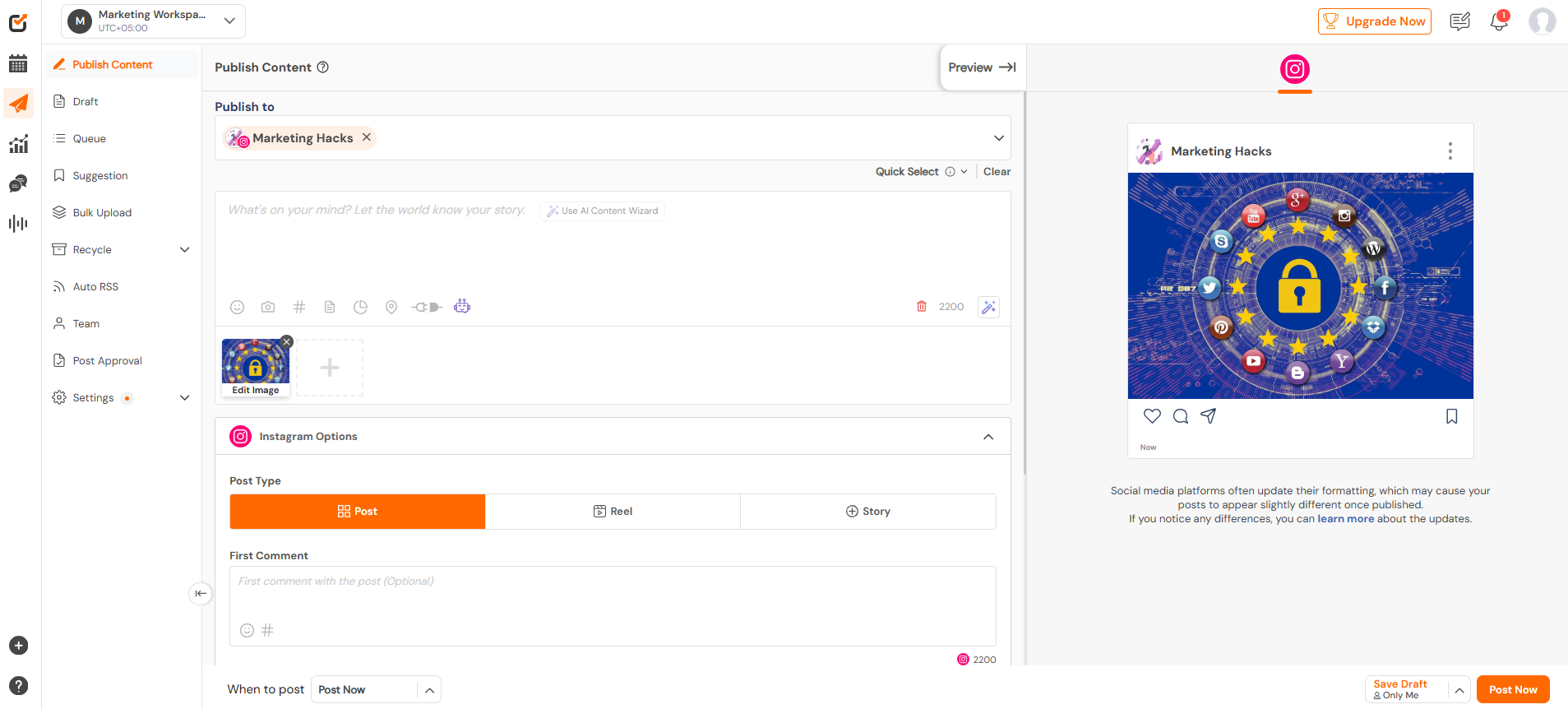
Social Champ’s Dashboard Agencies can easily toggle between these workspaces without the risk of posting under the wrong brand.
- User experience is smooth and intuitive with drag‑and‑drop calendars and a single view of each client’s timelines. The platform allows role-based permissions, enabling you to assign team members as creators, approvers, or publishers. Clients can even review posts via a shareable preview link, significantly speeding up approvals
- It supports 11+ major social media platforms, including Facebook, Instagram, LinkedIn, Twitter (X), YouTube, Pinterest, TikTok, Google Business Profile, Mastodon, and even Threads and Bluesky. This wide network coverage allows agencies to serve clients across various industries without needing extra tools.
- The bulk upload tool accepts CSV files for up to 300 scheduled posts at once, while the “Recycle” feature automatically republishes top-performing content at set intervals perfect for maintaining steady engagement.
- Collaboration is a core strength. Social Champ offers role-based access, letting you assign creators, editors, reviewers, and publishers to specific brands. Internal comments help streamline feedback, while shareable content preview links allow clients to review and approve posts without creating an account making approvals quick and painless.
- Automation tools extend capacity further. Auto-RSS connects trusted blogs or news sources to a brand’s queue, significantly reducing manual effort.
- The Champ AI Suite assists with crafting captions, generating visuals with AI Imaginator, analyzing tone, and suggesting optimal posting times based on past performance.
- Analytics and reporting include detailed dashboards across all channels, downloadable white-label PDF/PPT/CSV reports per brand, integration with GA4, and even competitor benchmarking.
- Teams also benefit from a unified inbox that consolidates comments, messages, and tags, assignable to team members along with collision detection to avoid duplicate responses.
In summary, Social Champ offers intuitive brand workspaces, powerful collaboration tools, automation features, and customized analytics, making it a top choice for agencies managing multi-client workflows.
CTA: Tired of Jumping Between Tools?
Schedule, collaborate, analyze, and automate all from one place. Social Champ replaces five tools with one clean interface.
-
Sendible
Sendible is popular among agencies that value structured multi-client management, especially thanks to its emphasis on brand safety, templates, and client engagement.
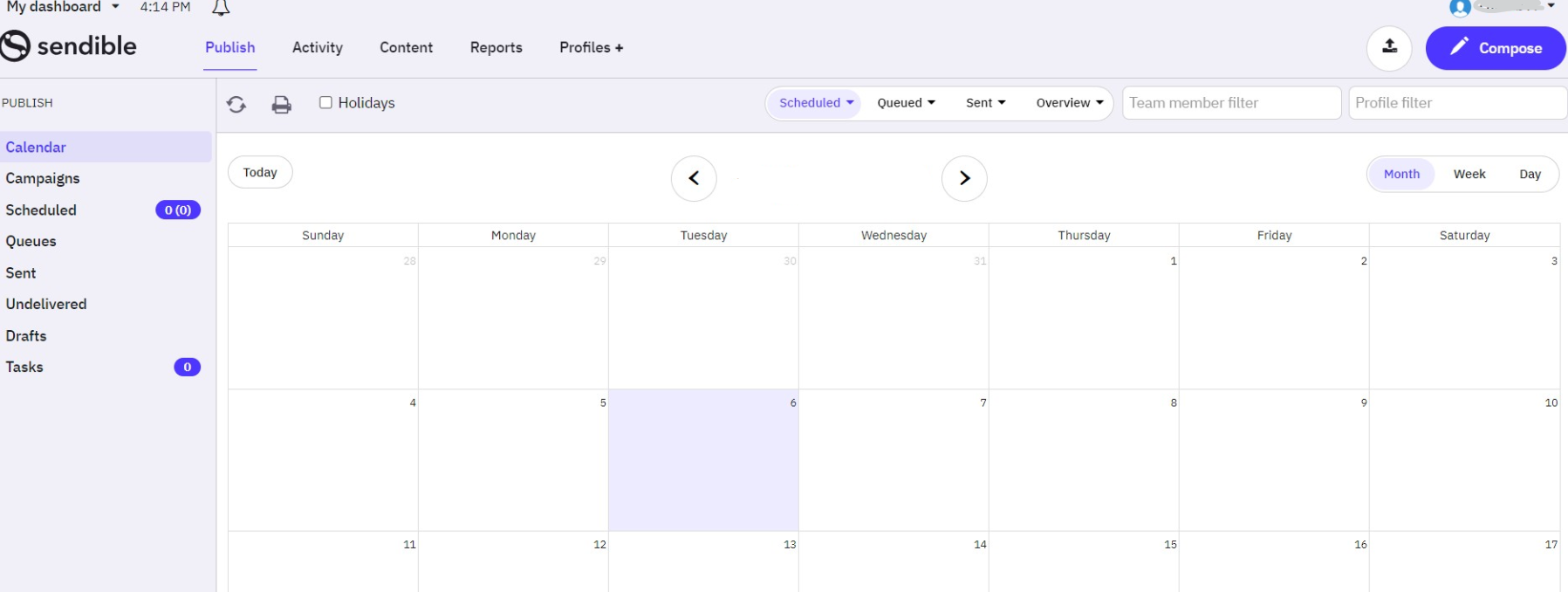
Sendible’s Dashboard Every account has its own dashboard complete with scheduled posts, content library, social inbox, and analytics bundled under separate brand profiles to prevent any overlap.
- The approval workflow is particularly streamlined. Users in creator roles draft content and submit it for internal review or direct client approval. Clients can review and approve posts via email or a lightweight portal; logging in is required.
- Scheduling features include smart queues, bulk uploads (up to 350 posts via CSV), and Canva integration. Posts can be tailored to specific platforms with previews for alignment and formatting especially useful when working with image-heavy brands.
- Social Inbox centralizes all client engagement comments, mentions, and replies across profiles. It supports filtering, tagging, and assignment to specific team members. This increases responsiveness and ensures no message goes unanswered.
In sum, Sendible’s brand-specific dashboards, approval flows, engagement inbox, and custom reporting make it a compelling choice for agencies needing organized, scalable workflows across multiple clients.
Featured Article: Is Vista Social Pricing Worth the Cost? Here’s What You’re Actually Paying For
Best Social Media Management Tool for Visual Content Planning & Scheduling
Visual planning and scheduling tools help agencies craft stunning content with precision timing and cohesive design.
Ideal platforms in this space combine visual calendars with direct design integrations so teams can plan, preview, and polish posts before they go live.
The two best social media management tools for agencies here are Later and Loomly.
-
Later
Later focuses on visually organizing content for brands where imagery matters most think fashion, travel, food, and lifestyle.
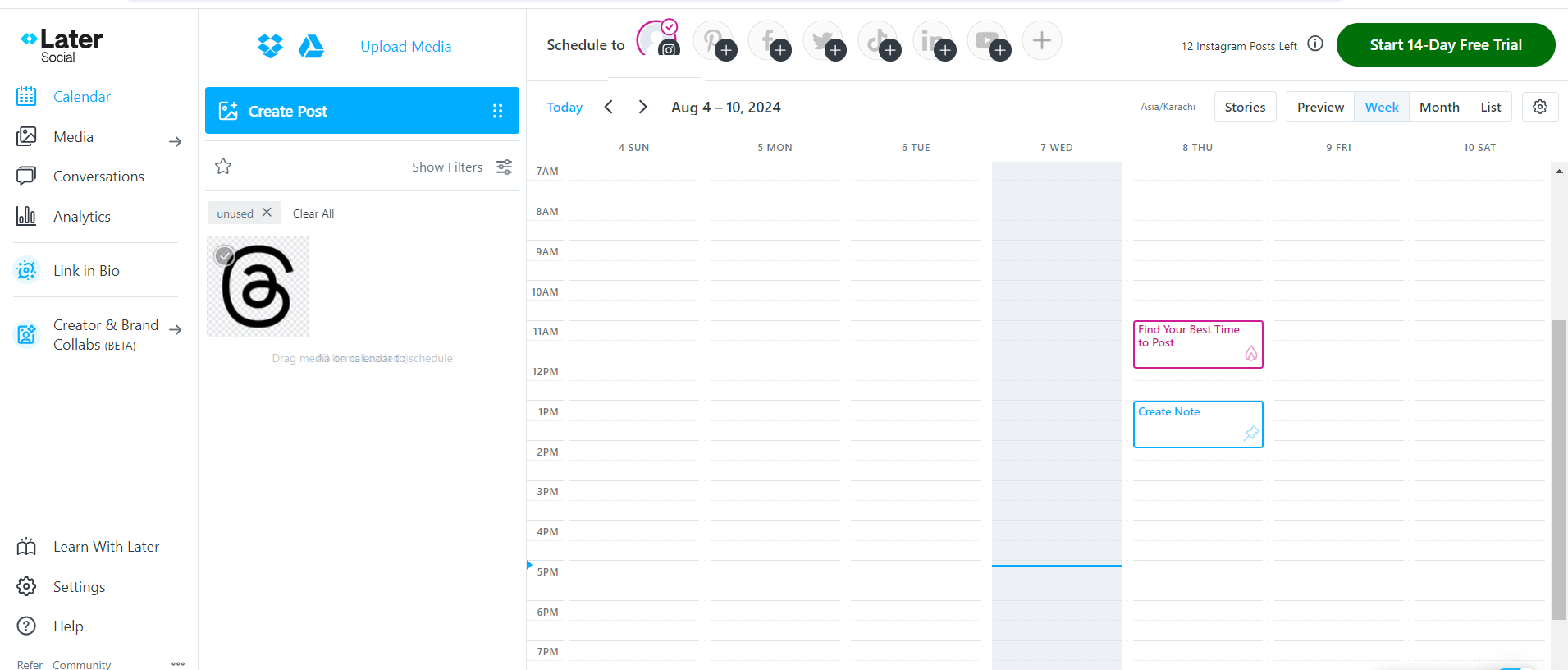
Later’s Dashboard Its drag-and-drop Visual Planner lets users upload media, map out content schedules on a calendar grid, and tweak posting order effortlessly for building cohesive Instagram or Pinterest aesthetics.
- One major pro of Later is its auto-publishing support across Instagram (including Carousels and Reels), TikTok, Facebook, LinkedIn, Twitter, Pinterest, and YouTube.
- Media management is another strength. Later allows unlimited media storage, plus features like caption + hashtag templates, user-generated content discovery, and built-in UGC tools. You can even build a shoppable Link-in-Bio page to drive traffic and track conversions directly from content.
- Onboarding is smooth. Agencies report Later’s intuitive interface has a low learning curve, especially for visual workflows. And while it supports team collaboration with features like shared calendars and approval windows, its collaboration tools are less advanced than those found in Loomly or Planable.
In summary, Later excels for agencies needing a visually focused planner with auto-posting, content discovery, and performance insights tailored to imagery-heavy brands.
-
Loomly
Loomly combines visual planning power with rich scheduling and collaboration features ideal for agencies who want both creativity and control.
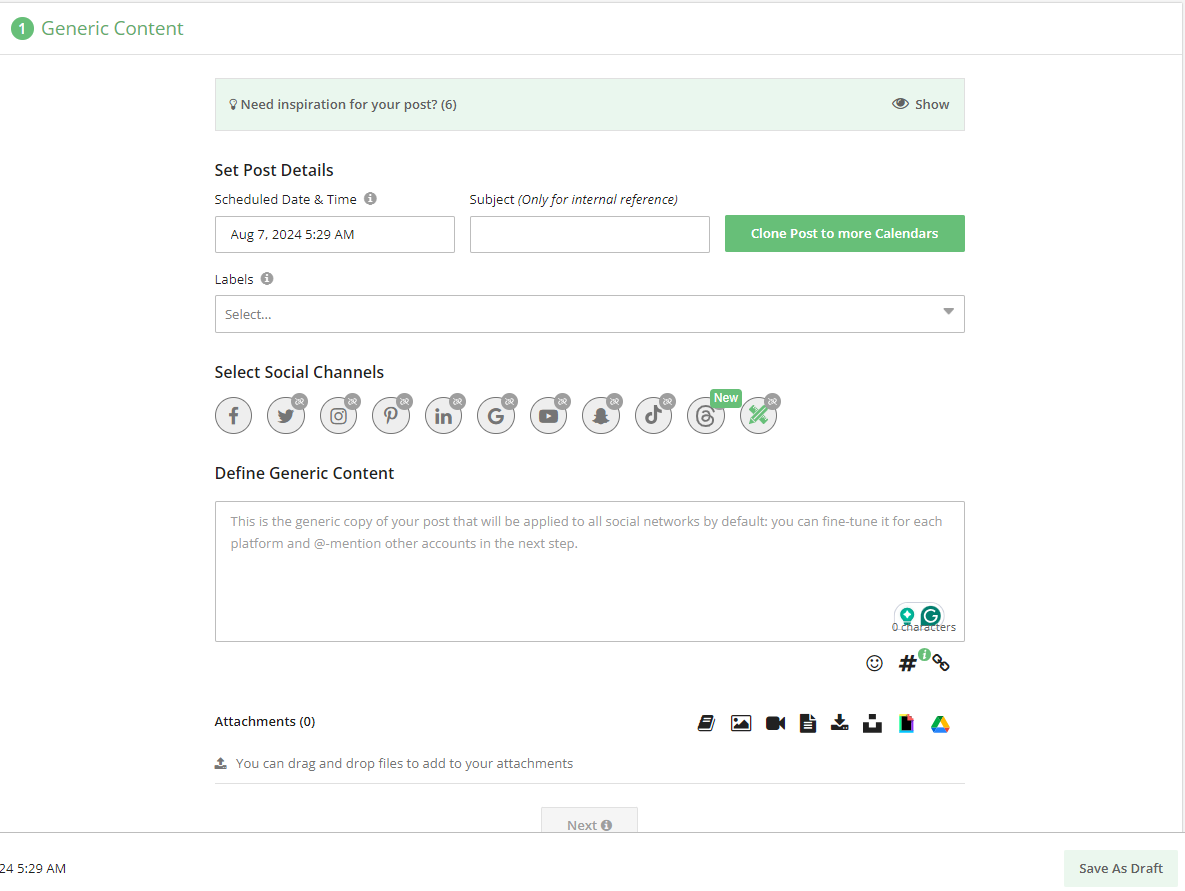
Loomly’s Dashboard At its core is a visual content calendar, with drag-and-drop scheduling across all platforms, offering a snapshot of every planned post across client accounts.
- The post creation flow is built for precision. It includes built-in editing tools, a canvas for images/videos, and native previews to ensure posts look perfect for each platform.
- Loomly supports rich content formats like Reels, Stories, and Carousels, with mockups available for every channel.
- Teams benefit from advanced workflow tools such as labeling, campaign tagging, grid previews, and calendar reminders.
- Integration with Canva, Unsplash, GIPHY, Google Drive, and Loomly’s native editor means assets are easily sourced and edited within the platform. Users appreciate how this centralizes the creative process and reduces switching between apps.
- Loomly also offers post optimization recommendations, including hashtag suggestions, alt text pointers, and best-time publishing guidance. It supports branded reports and analytics dashboards, where agencies can review campaign performance by platform, label, or KPI.
In summary, Loomly offers a robust fusion of visual scheduling, editing integrations, workflow control, and client-ready previews for visually driven agencies that prioritize both aesthetics and process integrity.
CTA: Scheduling Feels Manual? Automate It.
Use bulk upload, repeat posts, and Auto RSS to save hours every week with Social Champ’s smart scheduling features.
Best Social Media Management Tool for Real-Time Collaboration
For agencies handling tight deadlines, multiple stakeholders, and fast-paced content cycles, real-time collaboration is crucial.
The best tools provide shared calendars, instant feedback, comment threads, and visual previews designed to keep teams and clients aligned at every stage.
Here are two top performers:
-
Sprout Social
Sprout Social is engineered for seamless team collaboration across content planning, engagement, and analytics.
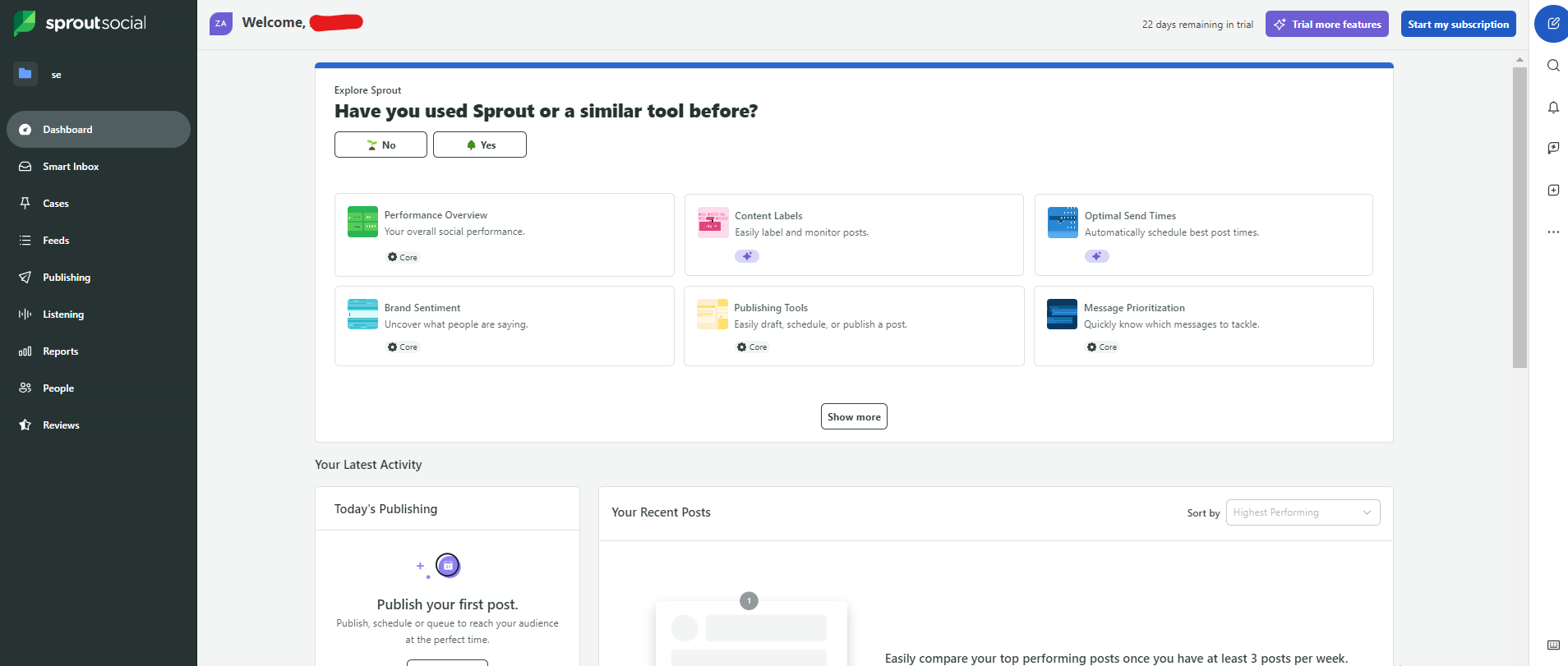
Sprout Social’s Dashboard - Its Shared Publishing Calendar provides a central hub where teams schedule posts, attach campaign notes, and assign publishing tasks. Calendar notes allow users to mark placeholders for major campaigns, ensuring context is clear and preventing content overlap.
- Comment threads support real-time communication: users can discuss draft posts directly within the compose window, mention teammates, and assign tasks without leaving the platform.
- Approval workflows shine with External Approvers. Clients or stakeholders added via email receive draft content, offer feedback, and approve posts without logging in. Assignable approval stages keep teams accountable and speed up turnaround.
- Engagement is enhanced by Sprout’s Smart Inbox, which supports sentiment filters, tagging, and team assignments ensuring quick, coordinated responses.
- It also integrates with tools like Salesforce, Tableau, and Google Analytics, aligning social output with brand-wide metrics and cross-team insights.
Users appreciate Sprout’s intuitive interface and real-time feedback loops. It empowers teams to work together seamlessly regardless of location, which is perfect for remote or hybrid firms.
-
Planable
Planable is purpose-built for visual collaboration, offering real-time feedback on designs, captions, and layouts before scheduling content.
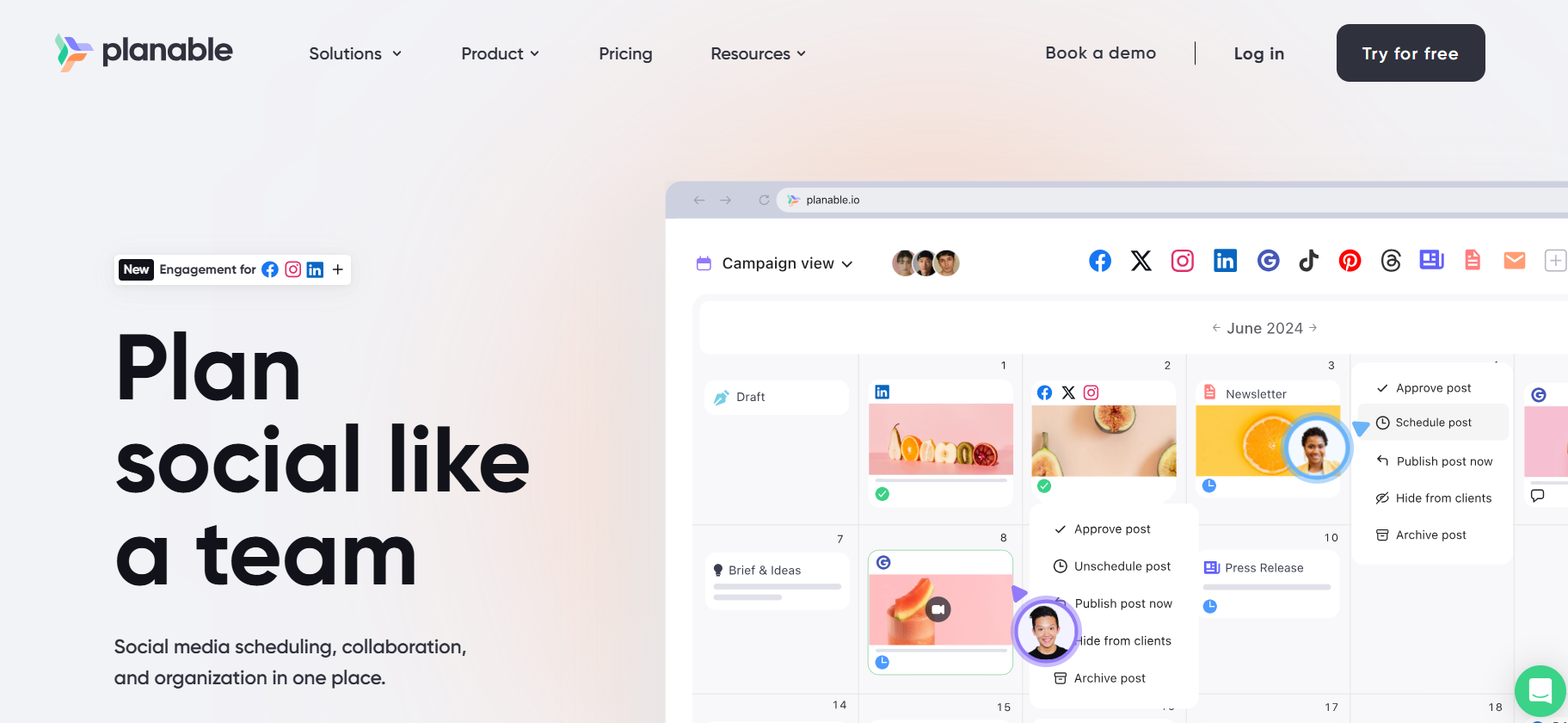
Planable Landing Page Its multi-view planner includes Feed, Calendar, Grid, and List views. Each offering visual previews and in-context commenting to streamline ideation.
- In Feed view, posts behave like real social feeds users comment directly beneath drafts, attach files, tag people, and resolve threads all without leaving the platform. The Grid view helps teams visually refine brand aesthetics, especially useful for Instagram. Users can drag and drop images to perfect the grid layout before pushing live.
- Planable supports real-time edits. Assets Images or videos can be trimmed or resized within the composer and shared instantly with collaborators for feedback. Labels, tags, and color-coding enhance content organization by campaign or client, and version history ensures changes are tracked and reversible.
- Its approval workflow enables multi-step reviews. Internal teams first approve, and then the content moves to external clients via shared links or email notifications. Once clients approve, scheduling becomes a one-click process.
- Planable also supports engagement. A unified comment inbox aggregates team and client inputs across posts, making it easier to address feedback without miscommunication.
In a nutshell, Planable’s intuitive, collaborative interface makes it ideal for agencies prioritizing shared creativity, live editing, and client-facing transparency all within a single platform.
Best Social Media Management Tool for Analytics and Reporting
For agencies, data isn’t just numbers what drives strategic decisions, client retention, and budget justification. The right social media management tool doesn’t just track engagement; it translates performance into insight.
Tools like Agorapulse and SocialBee give agencies full control over how metrics are captured, visualized, and presented, with features built for depth, customization, and scale.
-
Agorapulse
Agorapulse offers one of the most comprehensive analytics suites tailored to agency-level reporting. What sets it apart is its modular approach to data.
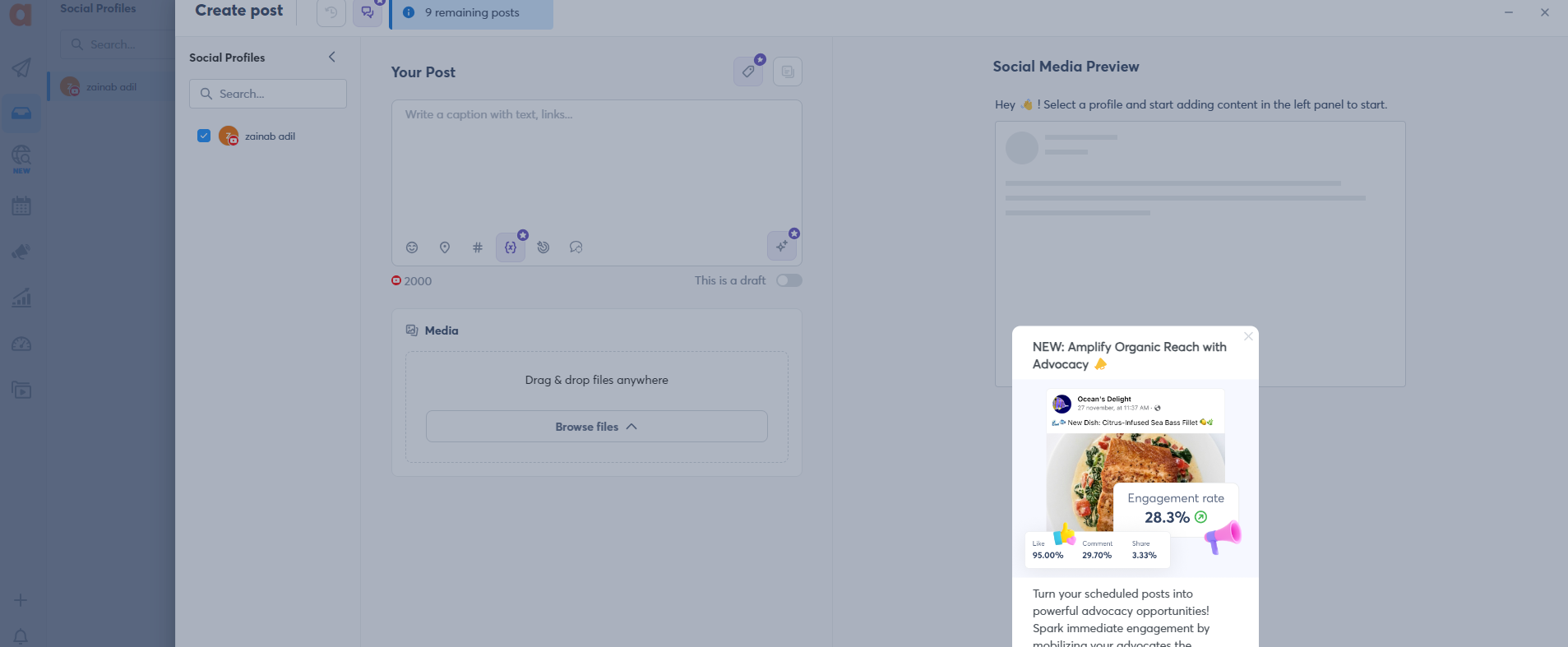
Agorapulse’s Dashboard Instead of showing you everything in one overwhelming dashboard, it lets you build reports based on the exact KPIs a client cares about.
- With the Power Reports feature, agencies can pull data across multiple social media profiles and compile fully customized, branded reports. Whether it’s engagement growth, response time, content types, or campaign-specific tags, every element can be selected, rearranged, or excluded depending on the reporting objective.
- Reports can be scheduled for automatic delivery at fixed intervals, removing manual effort from the equation.
- Agorapulse also includes detailed metrics on team performance, making it easy to assess internal workflows like average response time, number of interactions per team member, or ticket closure rates. This is especially useful for agencies with dedicated community managers or social care teams.
- Agorapulse also allows performance benchmarking against competitor pages, giving you a relative measure of client growth and visibility in crowded niches.
For agencies that need deep analytics with flexible output and high client presentation value, Agorapulse delivers reporting as a strategic asset, not just a back-end function.
-
SocialBee
SocialBee focuses on clarity and efficiency in reporting, ideal for agencies that manage multiple client brands and want results presented in an accessible, decision-ready format.
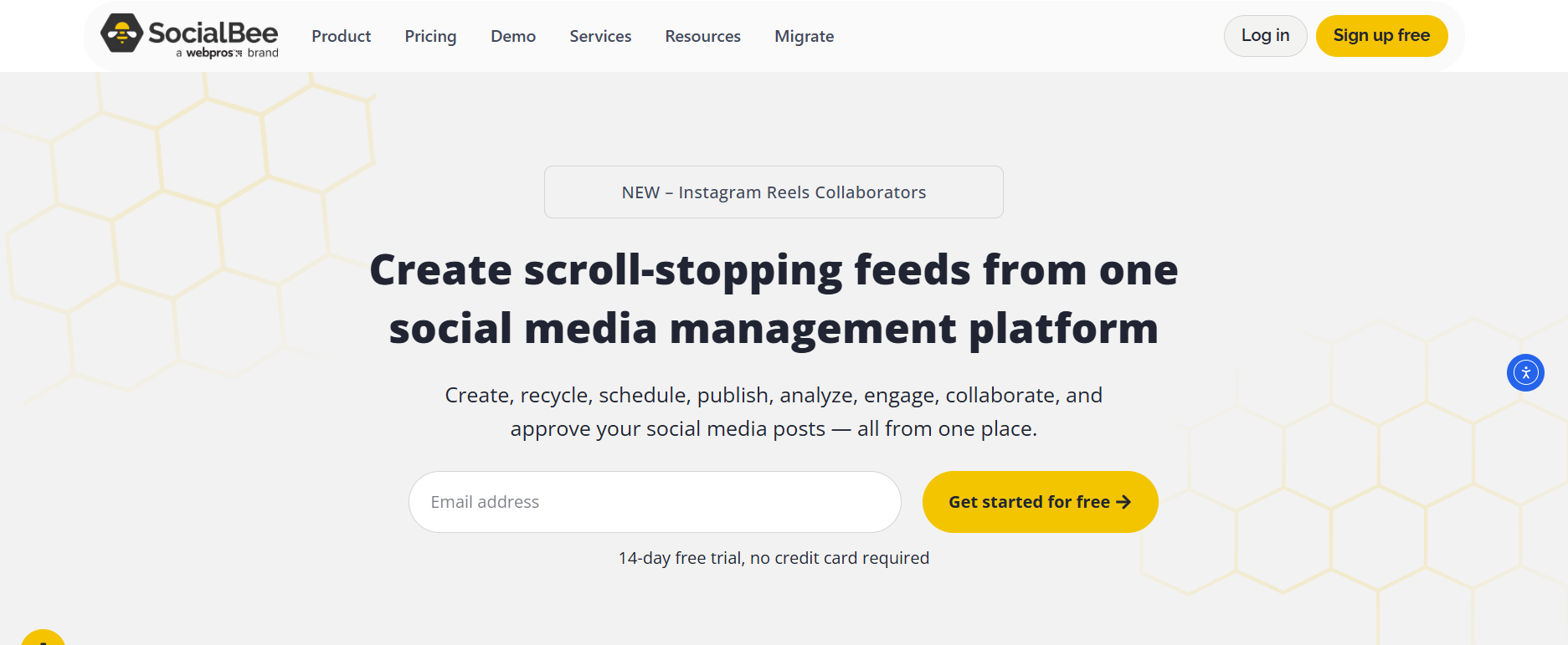
SocialBee Landing Page Its analytics dashboard offers a clean visual breakdown of performance across social media platforms, highlighting the core metrics that matter without unnecessary clutter.
- Agencies can quickly filter and identify top-performing posts by reach, clicks, saves, and shareability. This helps not only in reporting but also in shaping future content calendars with proven formats.
- SocialBee also includes click and link tracking integrated with UTM parameters. This is especially valuable for agencies focused on conversion-based campaigns or traffic-driven strategies
- While it doesn’t offer competitive benchmarking or paid ad data like Agorapulse, SocialBee’s strength lies in fast, flexible reporting. Branded PDF reports can be generated in a few clicks and include charts, summaries, and exportable insights per platform and per post. This allows account managers to turn around monthly or even weekly reports with minimal time spent.
For growing teams or agencies with light-to-mid analytics needs, it delivers smart insights, fast turnaround, and enough flexibility to meet client expectations without overwhelming the team.
CTA: Affordable, But Fully Loaded.
Social Champ offers multi-account support, analytics, integrations, and automation without bloated pricing.
Best Social Media Management Tool for Budget-Conscious Agencies
For agencies keeping a close eye on budgets, finding a tool that delivers essential features without price tags associated with enterprise-level platforms is vital.
Cost-effective solutions need to balance affordability with actual impact providing scheduling, reporting, team access, and multi-account management without hidden costs.
The two best tools here are Zoho Social and Buffer, each offering practical, scalable features tuned to agencies that want solid performance without breaking the bank.
-
Metricool
Metricool is one of the most generous platforms when it comes to delivering value at a competitive price.
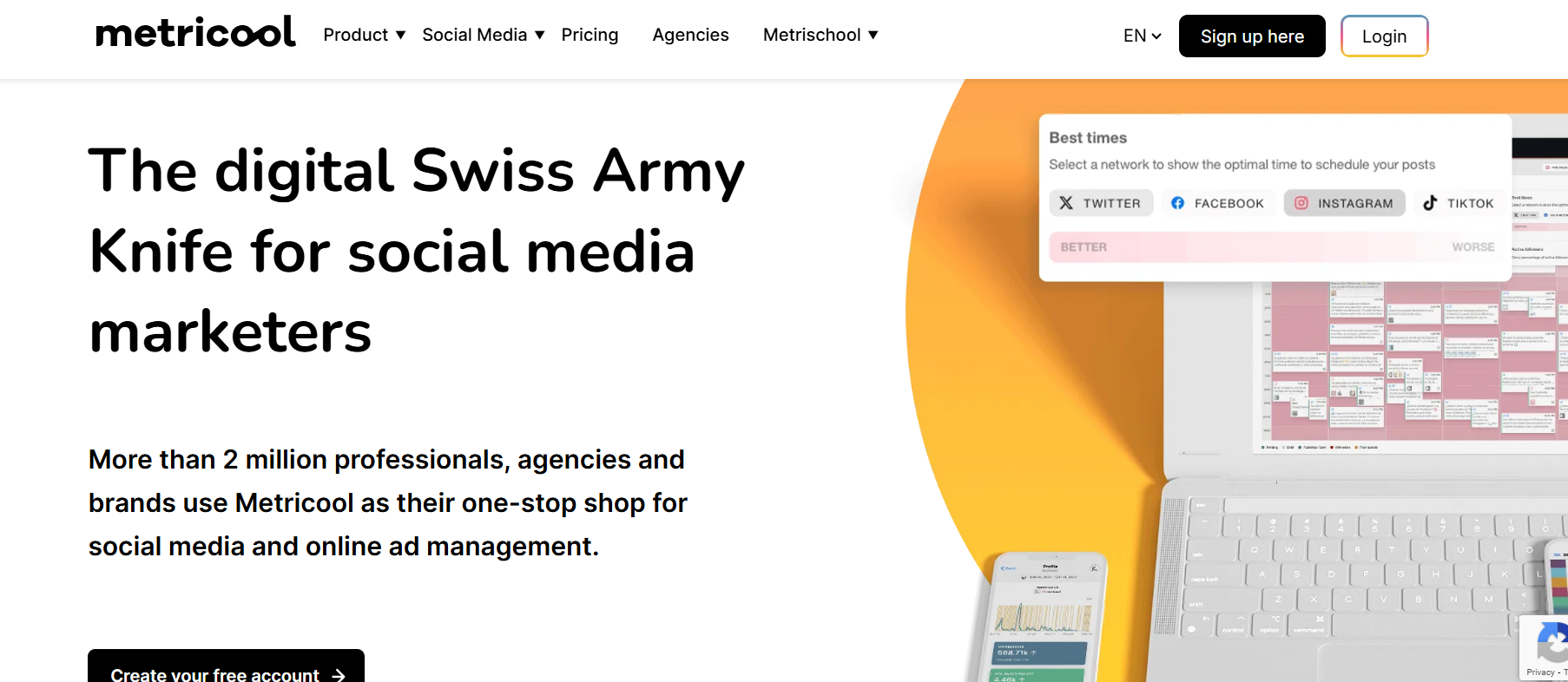
Metricool Landing Page It offers flexible plans that suit solo freelancers, growing boutique agencies, and large client rosters.
- Its Starter Plan begins at $18/month (annual billing) or $22/month (monthly) and offers a complete scheduling system, Canva integration, link tracking with SmartLinks, and downloadable reports in both PDF and PPT formats. You can manage all your social accounts (excluding Twitter without the add-on) and schedule unlimited content across platforms.
- The Advanced Plan, priced at $45/month (annually) or $54/month (monthly), unlocks full agency features. This includes team and client access, post approval workflows, role-based user management, and custom report templates crucial for structured, collaborative work. It also gives access to Twitter/X and expands publishing options further.
- Metricool’s visual planning calendar is intuitive and fast. You can drag and drop posts, auto-schedule using custom rules, or upload posts in bulk via CSV.
- The analytics suite is detailed and easy to present. It includes insights on audience demographics, post-performance, engagement trends, and competitive benchmarking. Even on the Starter Plan, you get data from 100 competitor profiles for performance comparisons or social audits.
If you’re a growing agency looking for a tool that balances advanced workflows with affordable, transparent pricing, Metricool is a strong contender.
It delivers the structure, analytics, and scheduling power agencies need without forcing you into high-cost tiers right away.
-
Buffer
Buffer is a trusted name in social media management, especially among small teams and agencies that prioritize usability and price transparency.

Buffer’s Dashboard - Its pricing is simple and channel-based, starting at $6/month per social channel on the Essentials Plan. This includes unlimited scheduled posts, a drag-and-drop calendar, one user seat, and access to an AI Assistant.
- For collaboration, Buffer offers the Team Plan at $12/month per channel, which adds unlimited user accounts, role-based access, and content approval flows. This is where it becomes agency-friendly, especially for teams who want to manage several users without ballooning their costs.
- The interface is clean and fast. Buffer’s content queue lets you line up posts by day, time slot, and platform. You can customize each post per channel, drag content to new slots, or clone posts with one click. It’s designed to speed up scheduling, not complicate it.
- Its biggest strength for budget-conscious agencies lies in its scalability. You only pay for what you need, forced jumps to expensive plans just to unlock collaboration or analytics. That modularity gives agencies full control over how much they spend as they grow.
If your agency handles fewer clients or wants a lean, focused solution that scales at your pace, Buffer offers dependability, affordability, and a frictionless user experience.
Best Social Media Management Tool for Integrations and Automation
Tools that offer deep integrations and powerful automation features help agencies stay lean, efficient, and client-ready at all times.
Hootsuite and CoSchedule both excel in this space, with robust automation engines and broad platform compatibility that streamline day-to-day operations.
-
Hootsuite
Hootsuite has built its reputation around flexibility, and that extends to how well it integrates with the broader marketing tech stack.
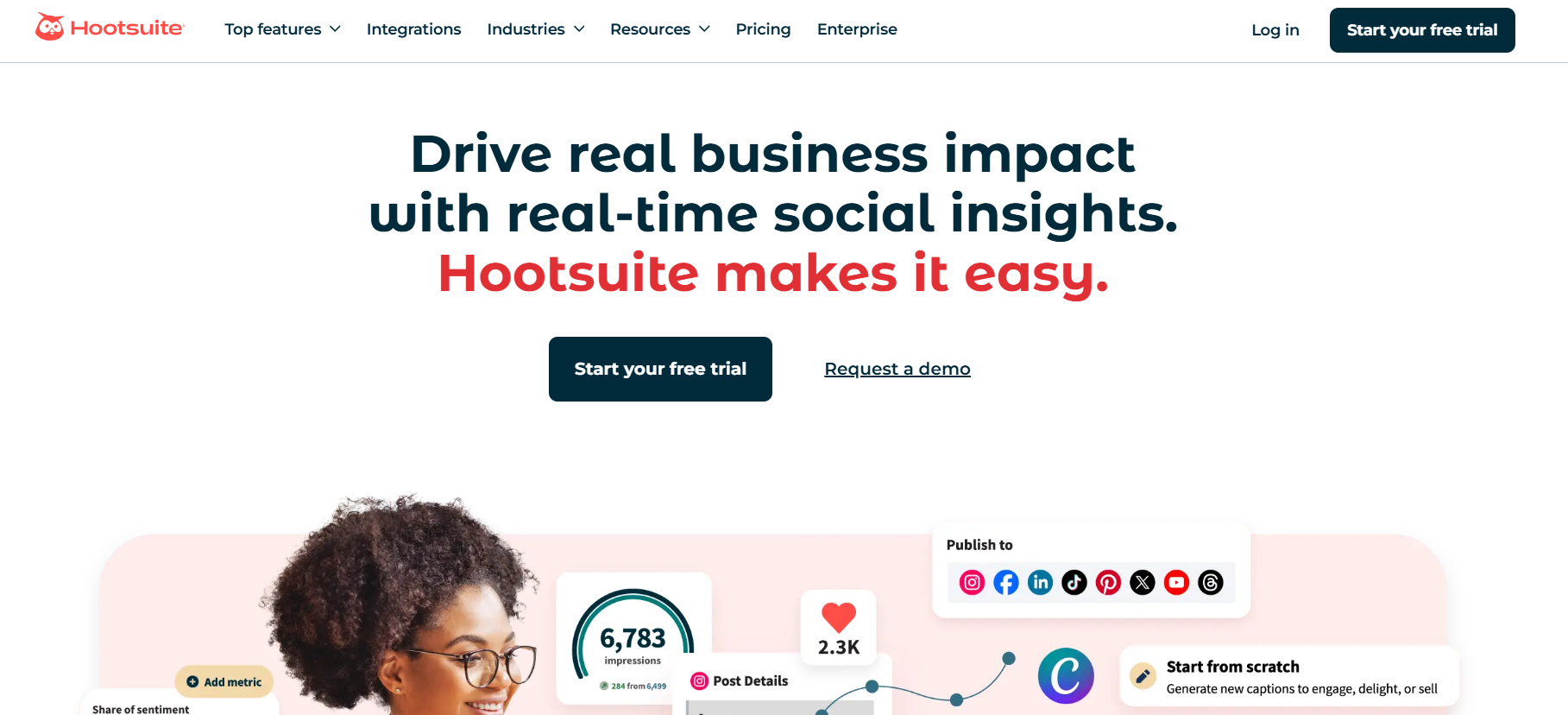
Hootsuite Landing Page - It connects with a vast array of apps either natively or through Zapier, including Slack, Google Drive, Trello, HubSpot, Airtable, and more. This gives agencies the freedom to plug Hootsuite into whatever ecosystem they already use, without disrupting processes.
- One of Hootsuite’s standout automation features is AutoSchedule, which selects optimal posting times for each social network based on past performance.
- Content can be bulk-upload via CSV, and teams can build reusable content templates that reduce time spent on repetitive copywriting tasks.
- Its Streams dashboard is highly customizable, allowing users to monitor mentions, keywords, inbox activity, and performance metrics in real time.
For agencies juggling dozens of clients and campaigns, these integrations and automations significantly cut down on redundant actions and increase visibility across teams.
-
CoSchedule
CoSchedule positions itself as a centralized marketing command center one that connects not just social media, but blogs, emails, and tasks.
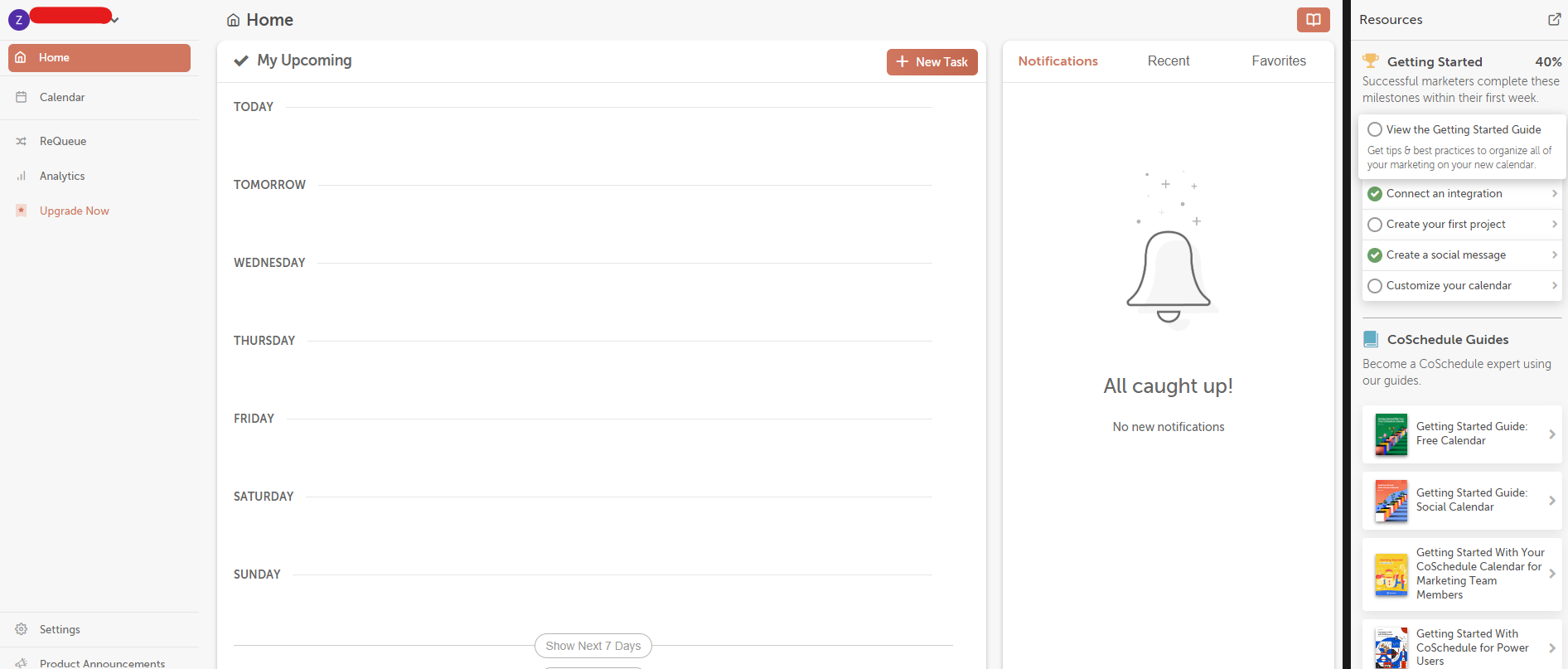
CoSchedule’s Dashboard Its value lies in how it brings these pieces together in a single, organized calendar, helping agencies visualize and execute campaigns holistically.
- Key integrations include WordPress, Google Calendar, Slack, Mailchimp, and Trello, with automation running through native functions and Zapier.
- The real magic of CoSchedule lies in its ReQueue system. ReQueue lets you create content buckets for high-performing posts and automatically redistributes them at optimal times, filling calendar gaps without needing to reschedule manually.
- Automation within CoSchedule also applies to team processes. For example, publishing a blog on WordPress can automatically schedule corresponding social posts, update the calendar, and notify the assigned team members in Slack via Zapier integrations. This cross-functional automation keeps everyone aligned and removes unnecessary admin work.
- The visual calendar is the interface’s core, allowing teams to see everythingtasks, content pieces, post slots, and campaign progress in one view. You can color-code entries by client, drag posts into new slots, and duplicate entire campaigns with just a few clicks.
For agencies that run content marketing and social media hand in hand, CoSchedule offers the structure and automation to manage everything in one place.
It ensures that nothing falls through the cracks, even when multiple projects are running in parallel, making it a true workflow unifier.
Why Social Champ Is a Top Choice for Agencies?
Agencies don’t need five different tools to manage five different challenges. They need one that understands all of them.
Social Cham is a well-rounded platform because it directly addresses the daily demands agencies face from managing multiple clients and collaborating with teams to producing content at scale, automating processes, and delivering insightful reports.
Here’s how Social Champ holds its own across every core capability discussed above.
-
Scalable Client Management
Social Champ lets you manage multiple clients effortlessly using separate workspaces. Each brand’s accounts, schedules, and teams stay organized, with no cross-posting risks.
It supports 11+ social platforms, allowing you to switch between brands without breaking focus. Perfect for agencies managing diverse portfolios.
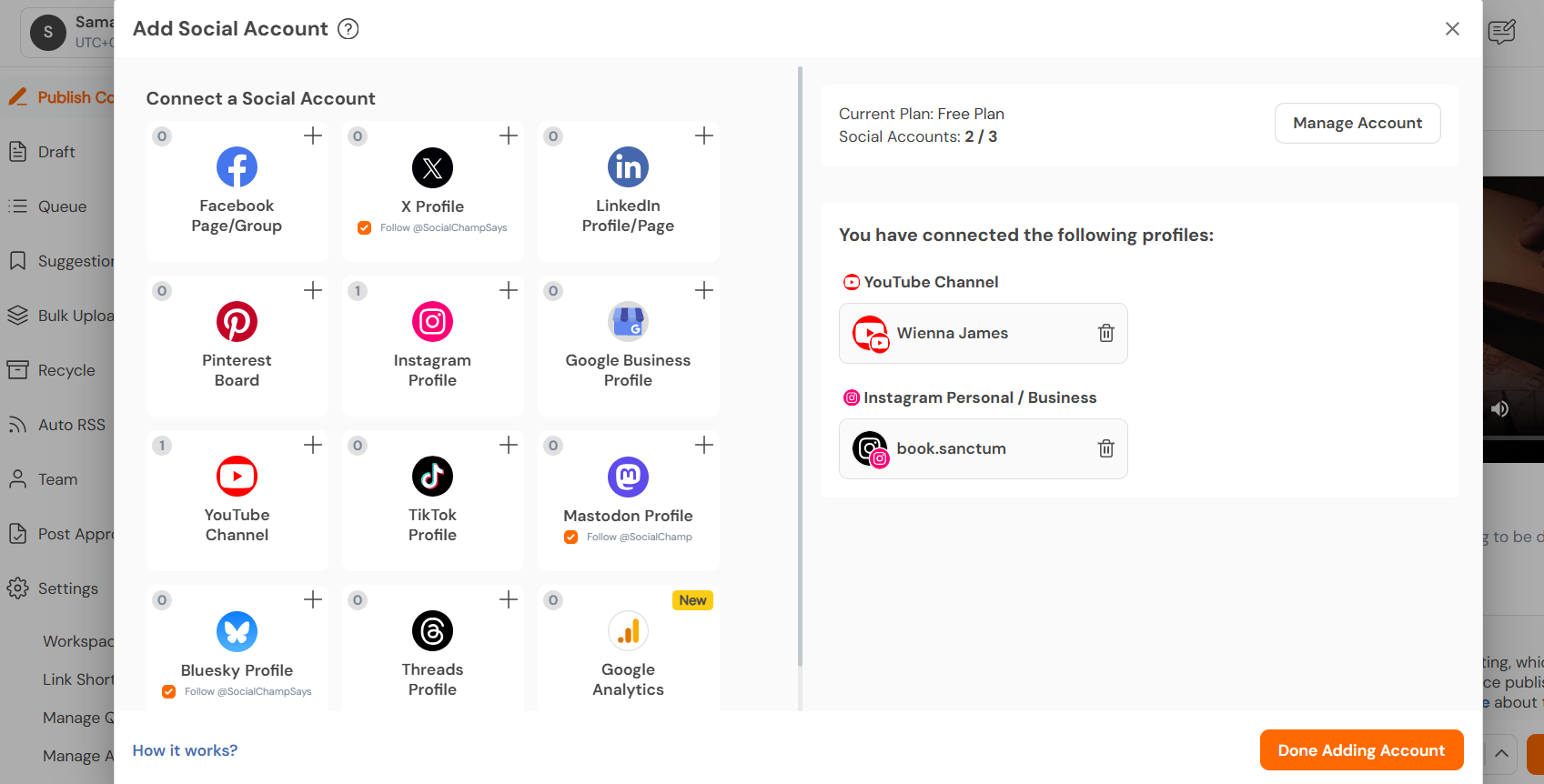
Social Champ Add Social Accounts Feature -
Visual Scheduling With Creative Control
With a drag-and-drop calendar view, Social Champ makes campaign planning easy and intuitive. You get instant visibility into what’s scheduled where.
Direct integration with Canva means visual assets are just a click away. Plus, features like bulk upload and repeating posts make high-volume planning simple.
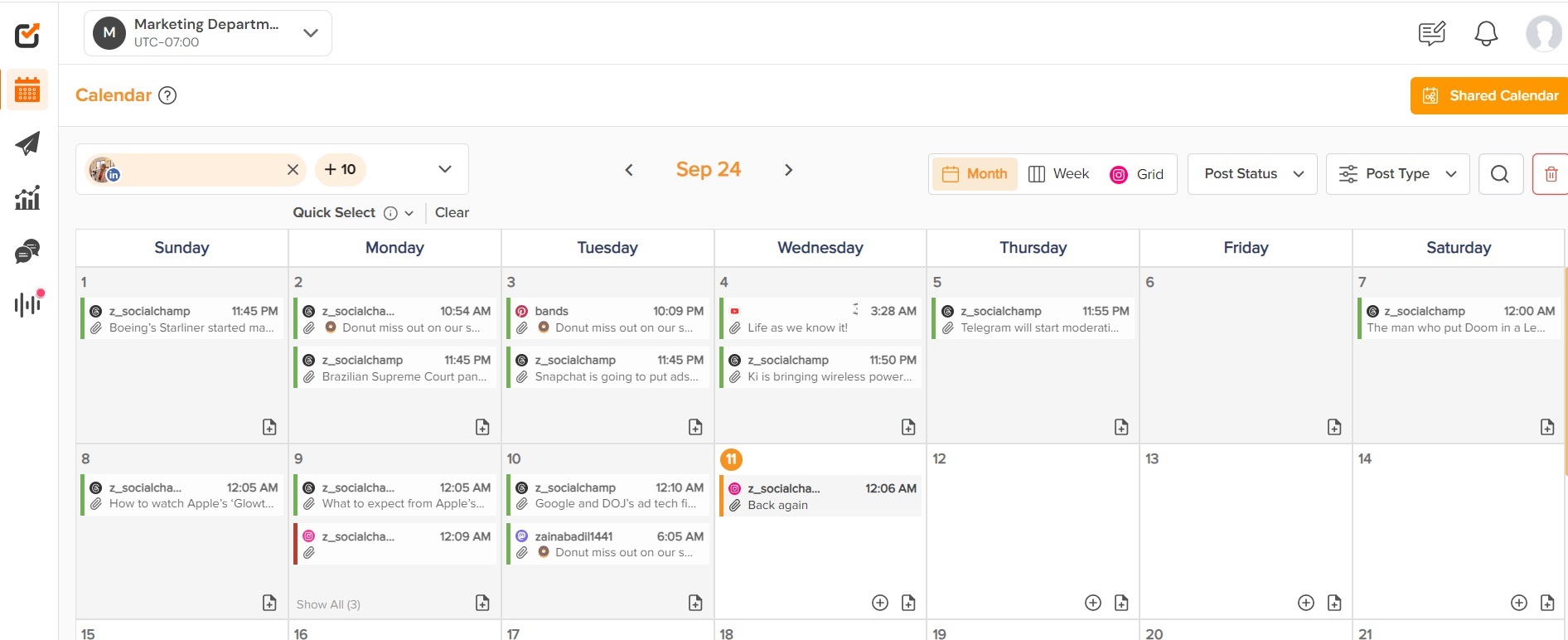
Social Champ Calendar -
Built-in Team Collaboration
Assign roles, streamline approvals, and keep everyone on the same page.
Social Champ supports multi-user workflows, letting teams create, review, and approve content efficiently.
Clients can approve posts directly from messy email threads or confusing chains of feedback.
-
Reporting That Tells a Clear Story
The analytics dashboard gives agencies real-time insights into engagement, reach, and performance.
You can generate clean, branded PDF reports for each client in just a few clicks. It’s everything you need for client updates without needing a separate reporting tool.
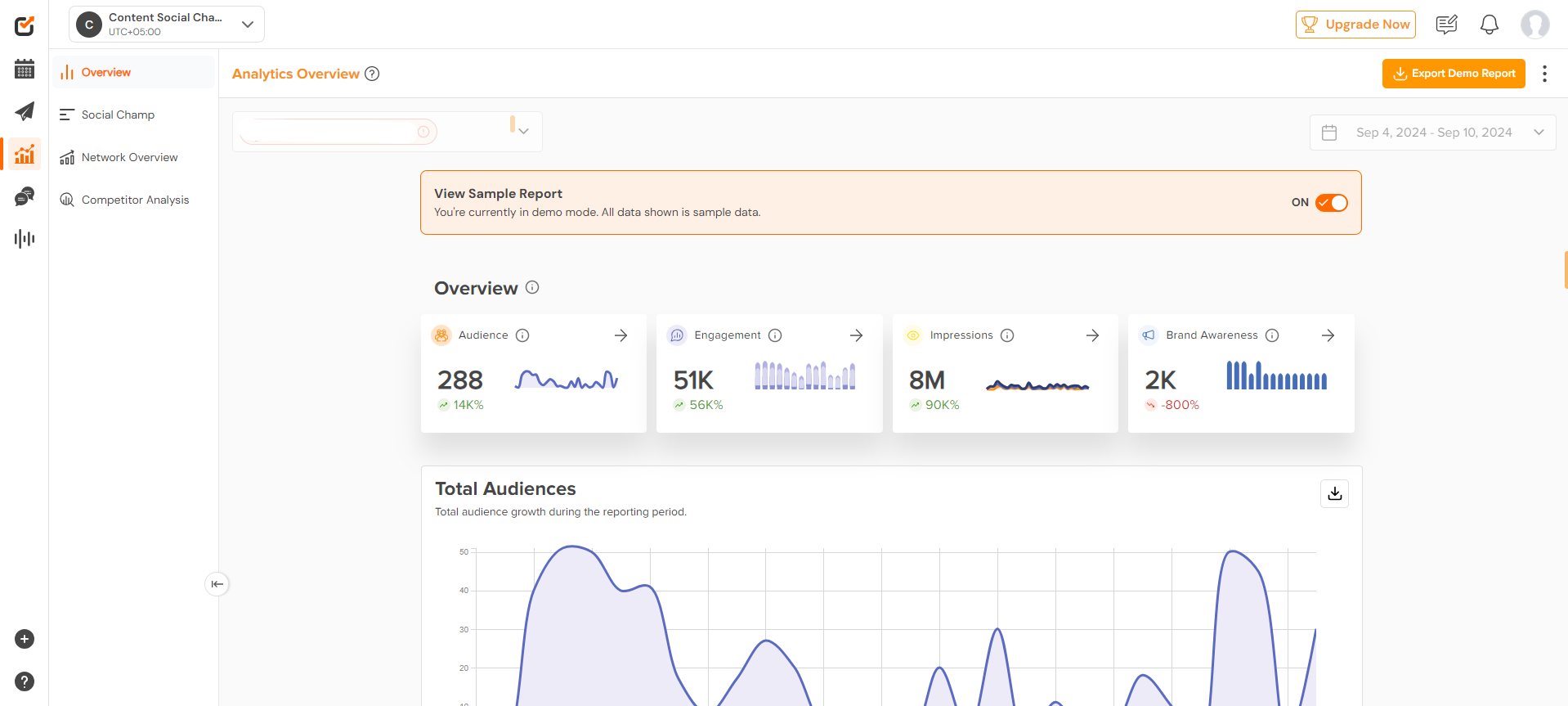
Social Champ Analytics -
Feature-Rich Without the High Cost
Social Champ offers powerful features without bloated pricing. You don’t need to pay extra for essentials like approvals, analytics, or workspace management.
It’s a budget-friendly choice for agencies that want full control without scaling costs.
-
Automation & Integrations That Save Time
Social Champ integrates with tools like Canva, Bitly, and Google Drive, plus supports Auto RSS posting.
Its queue management, recycling features, and bulk scheduling reduce repetitive tasks so teams can focus on strategy, not logistics.
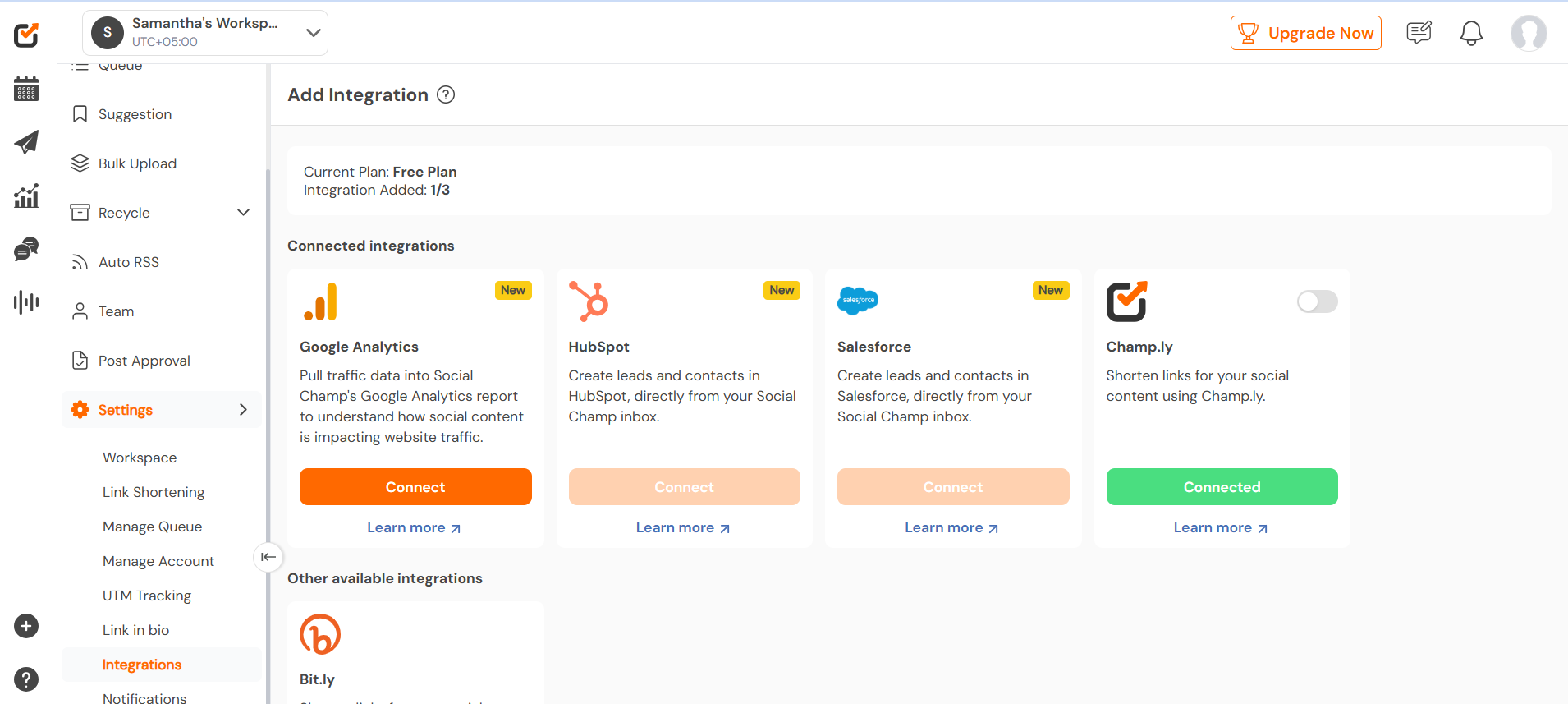
Social Champ Integration Dashboard CTA: Why Juggle Tools When One Does It All?
With Social Champ, schedule posts, collaborate with teams, track analytics, and automate content all in one dashboard.
Which Is the Right Social Media Management Tool for Your Agency?
Choosing the right social media management tool isn’t just about features about how well the platform fits your agency’s structure, workload, and goals.
Every agency has a different pace, team setup, and client expectation. Here’s how to narrow it down:
- Running multiple clients with different teams?
You need tools with clean workspace separation and role-based access. Social Champ and Hootsuite make it easy to manage distinct brands without overlap or confusion. - Handling visual-heavy campaigns at scale?Look for drag-and-drop calendars, design integrations, and bulk scheduling. CoSchedule and Social Champ are purpose-built for visual planners who need clarity and speed.
- Collaborating daily across writers, designers, and approvers?Go with platforms that offer real-time feedback, approval flows, and internal comments. Social Champ and Buffer stand out for simplifying team reviews without extra software.
- Focused on reporting and performance?Choose a tool that offers client-ready analytics and customizable reports. Sprout Social and Metricool are strong here, but Social Champ offers this without inflating your stack.
- Tight on budget, but need full functionality?Social Champ and Metricool offer high-value plans that don’t compromise on must-have features like scheduling, approvals, and analytics.
- Looking to automate and integrate across your tech stack?CoSchedule and Hootsuite provide deep integrations. But for a clean balance of automation, usability, and cross-platform publishingSocial Champ delivers without complexity.In short, choose the tool that doesn’t just check boxes but complements how your agency actually works.If you’re looking for a platform that scales with you, supports your team, and keeps your clients happySocial Champ is worth putting at the top of your list.
Conclusion
Managing social media for multiple clients takes time, coordination, and the right tools. The platforms covered in this guide each offer something different are better for visuals, others for automation, analytics, or team collaboration.
If your agency needs a tool that brings everything together in one place scheduling, reporting, approvals, and more, Social Champ is a strong choice.
It’s easy to use, built for teams, and works well whether you’re handling two clients or twenty.
Pick the tool that fits your workflow, meets your clients’ needs, and helps your team stay on track. The right platform will save you time, reduce stress, and help you deliver better results.
